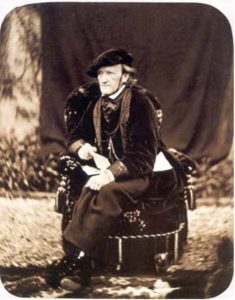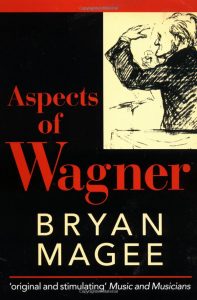About Richard Wagner
Aspects of Wagner
Information from the book Aspects of Wagner, by Bryan Magee.

Richard Wagner at his home “Tribschen” in Switzerland (1866)
Bryan Magee’s synopsis of Wagner’s theories of art:
“The highest point ever reached in human creative achievement was Greek tragedy. This is for five main reasons, which should be considered together:
- It represented a successful combination of the arts – poetry, drama, costumes mime, music, dance and song – and as such had greater scope and expressive powers than any of the arts alone.
- It took its subject matter from myth, which illuminates human experience to the depths, and in universal terms. The myth is true for all times.
- Both the content and the occasion of performance had religious significance.
- It was a religion of the purely human, a celebration of life
- The entire community took part”
Magee goes on to say that as time passed, Greek art disintegrated, each art going its separate way, developing alone – instrumental music without words, poetry without music, drama without either, and so on. The content of art further dissolved when Greek humanism was superseded by Christianity that taught men to look at his body with shame, his emotions with suspicion, sensuality with fear, and love with guilt. The doctrine of man being a worm was at odds with the essence and nature of art. The descent reached its rock bottom by the 19th century, with the opera of that century, yet opera had the highest potential to combine all the arts, as Greek tragedy had done.
Wagner didn’t want to return to Greek tragedy, Magee explains. He wanted to create something better, because it could depend on resources that the Greeks never had.
Wagner considered Shakespeare “a genius the like of which was never heard of,” and Beethoven had developed the expressive powers of music beyond the limits of speech altogether, even the speech of Shakespeare. Wagner’s idea was to combine the achievement of Shakespeare and Beethoven into a single art form that would he called music drama.
Music drama would be all about the inner life of the characters; it would be concerned with their emotions. This feat had been made possible by Beethoven who had developed the power to express inner reality in all of its fullness.[1] In music drama, the externals of plot and social relationships are reduced to a minimum.
Magee explains that Wagner felt that myth was the ideal for this. Because it dwelt in archetypal situations and because of its universal validity, a dramatist could dispense with asocial and political context and present pure inner drama.
Magee explains that Wagner had a deep insight into the nature of symbolism (he was, after all, the progenitor of the symbolist movement in French poetry). He had the most remarkable understanding, long before psychology or anthropology, of the psychic importance of myth. He realized a half century before Freud that “Today we have only to interpret the Oedipus myth in a way that keeps faith with its essential meaning to get a coherent picture from it of the history of mankind.”
Wagner raised a storm of criticism in Europe unlike anything before witnessed. Magee believes that about 10,000 books and articles had been written before his death, and more books and articles were written about Wagner than any other human being except Jesus and Napoleon.
[1] Beethoven came at a time when the cerebral music of the Viennese composers was at its highpoint. Beethoven’s audiences were shocked by the emotion in his music. No one had ever expressed emotion in music to this degree before. Even the proudest, most prime ladies could unexpectedly break into tears during one of his recitals. [Footnote: DoveSong]
From the online book: Music Through the Centuries by Don Robertson (2005)
Published on DoveSong.com – Revised and expanded in 2023
Chapter Five – The 19th Century: “Heart”

